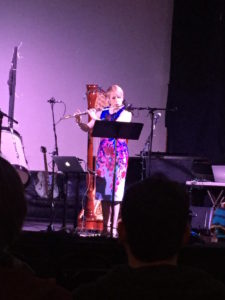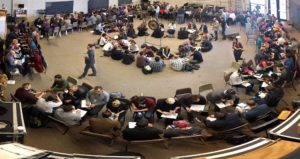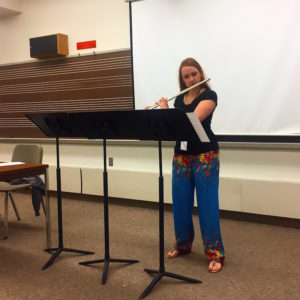New Friends at the New Music Gathering. By Rachel Hacker
I adore flute events as much as the next person, but attending a non-flute focused conference was a welcomed breath of fresh air. Having been to a lot of flute fairs named the “Northeastern/central/whatever college organization-Flute Workshop,” I expected the New Music Gathering to be the same as a flute fair. I anticipated a bento-box style sampling of lectures, performances, and open master classes. Two or more events will feature a guest artist, and another will discuss “entrepreneurship” in the broadest of contexts. Meanwhile, a clinician will try to teach the entirety of a specialty topic in 50 minutes. The congested exhibit hall contains a jungle of flutes that stick straight up like trees underneath a florescent light “sun.” Colleagues of distant years, and alumni of the host university, will congregate in recital hall lobbies, and speak in altissimo ranges, as to express genuine, or sometimes fake, excitement.
I may sound jaded on flute conventions, but I’ll still be found at as many of them as possible, simply because I think the flute is the coolest instrument ever. I’ll also continue to shell out money for airfare and hotels, until some schmuck with a big brain invents “virtual reality flute fairs” that can be attended from the comfort of our living rooms. Unless a virtual reality world consumes our lives, I’ll continue to be found in person, roaming the hallways of collegiate music buildings, or oversized convention centers, for a few days at a time.
Perhaps my own apprehension towards flute fairs is simply because I was ready to attend something new. I needed something that focused less on competitions and the retail aspects, and focused more on the people in attendance. Flute fair structures can be too formal for my tastes, and rarely offer enough opportunities for networking. Flute fairs are put in the awkward position of attempting to appeal a huge disparity of ages and interest levels. My dream for the future of flute fairs has been inspired by something that was not a flute fair, but instead, the 2017 New Music Gathering. The host university for 2017 was Bowling Green State University- with a large and well-equipped assortment of classrooms and performance spaces. Five New York-based composers founded the conference in 2015: Daniel Felsenfeld, Lainie Fefferman, Matt Marks, Jascha Narveson, and Mary Kouyoumdjian. Each of the founders is immensely an intelligent, personable, funny, and humble individual, with a list of impressive accolades.
As a current resident of the Cincinnati area, my drive to Bowling Green was a monotonous 2.5-hour drive straight up Interstate 75. Although the facilities of Bowling Green were a great place for the conference, I found the city itself to be somewhat isolated. The next major city was Toledo- about 30 minutes north of us, and Dayton was south of BG by about 1.5 hours. Nevertheless, the city of Bowling Green greeted me with a level of predictability that embodied my upbringing. Ohio towns are earnest, self sufficient, and comfortable, and Bowling Green was no different. I opted to stay at a Days Inn room by myself. The room had no windows, and was located just a few hundred feet from the noisy interstate. My hotel selection was less than perfect, but hey, they gave me a conference rate of $45 dollars a night, so the price was right.
I was awoken the first morning of the conference at 7:30 AM, because somehow the heater had turned on in my room. I didn’t figure out how to turn it off until the third day of the conference. As I prepared for the first day in my windowless room, I thought about all of the new people I will encounter over the next few days. I would be meeting multiple musicians and composers IRL- In Real Life. Would they be as nice as they seemed on Twitter or Facebook? Will we go to lunches and sit together at events, or will we have a brief, awkward, conversation, that ends with running out of things to say?
Arriving in the parking lot at 9:35 AM, I had until 10:00 to be registered before the first event started. I joined a line of eager looking participants near the registration table. I immediately recognized my first of many “Internet Friends.” I had met Andrew Rodriguez a couple of years ago on Twitter, and he is a composer from Texas, currently studying in Illinois. There was an immediate friendship between us, reminiscent of seeing a little brother, or an old friend from high school. Moments later, I found Columbus, Ohio based flutist Lindsey Goodman, who would be performing later that night. Lindsey is such a delightful and fun person to be around. After registering, I found another awesome flutist- Tammy Evans Yonce. Tammy writes a lot of album reviews for The Flute View, and is a professor at South Dakota State University. After a few minutes of casual conversation went by, we ended up having an intense discussion on the Glissando Headjoint. My friend Andrew actually wrote an awesome piece for Tammy and her Glissando Headjoint, called Highways, and Tammy would be doing a presentation on the Glissando Headjoint the following day.
The first event of New Music Gathering 2017 inadvertently became the ultimate convention icebreaker. As opposed to drinking two glasses of wine, or being stranded on a desert island, singing in a large group made me immediately feel more at ease with the room of familiar and unfamiliar faces. The composition was called The Great Learning, Paragraph 7, and was composed by Cornelius Cardew. The work is organized so that a large group will sing the lyrics on any number of indeterminate pitches, with indeterminate timings. The piece took about 40 minutes to complete, and it was a nonjudgmental environment where everyone, regardless of singing ability, could simply have fun.
After having met several of my friends, and participating in this rousing activity, I realized that this event is different and perhaps better from the usual flute fairs I had attended. The New Music Gathering is the modernized version of a flute fair, and it was exactly what I had been looking for. The youngest of participants were aged around 20, and the festival was not geared towards high school students. The majority of participants were graduate students, young professionals, or even tenured professors, of all kinds of instrumental backgrounds. I would estimate that half of the attendees are composers, which is obviously not a common site at a flute event. I perceived virtually every person I met as someone extremely dedicated to the present and future of music. The performance and study of new ideas in music was not just a hobby, but a well curated passion that they were eager to continue developing and improving.
Although there was a sizable sea of participants, no one appeared to feel lost or excluded. Everyone came to Bowling Green from a different corner of the globe, and everyone made new friends. Every person I sat next to, whether in the lobby, in a lecture, or a recital, was interested in conversing with me. It wasn’t a fake, nervous chatter, but a legitimate inquiry into the skills and ideas of someone to possibly collaborate with in the future. Perhaps the biggest thing missing from flute fairs is a consistent openness and desire to meet and interact with others. Maybe flutists are simply more reserved than composers or other instrumentalists, or maybe they view each other as competition. Regardless, I’ve learned that reaching out to someone new is more likely to turn into a positive situation than a negative one.
One highlight of this social time was when I met world acclaimed composer Jennifer Higdon. I passed her when walking the halls with a composer that is commissioned on my forthcoming album, named Griffin Candey. Although Griffin and I were in route to grabbing a classroom to work on our piece, we had no qualms in stopping to greet Higdon. As a flute player herself, she and I talked about my album, the Kingma System, and my beautiful Fluter Scooter bag. She was also complimentary of the score that Griffin had composed for me. This moment that I shared with Higdon was low key and friendly. I didn’t need to take a selfie with her in order to remember this satisfying and humble interaction. Occasions like meeting Jennifer Higdon have continued to reinforce my love and dedication to creating new works, and developing new musical ideas, with other living composers.
Speaking of camaraderie, flute fairs of the future may want to consider hosting fewer competitions. The New Music Gathering social environment works so well because the participants are there for their own desire to learn, instead of to win. I’m sure that a half-baked twenty-something has already written a think piece about the end of competitions on their blog, and I have my own brief spin on the opinion. Through exploring my own professional shortcomings from the past couple of years, I’ve observed that life is a constantly ebbing flow of failures and successes, so why hang your hat on winning a competition or two? I have observed that the community of new music performers and creators tend to focus on inclusivity. In contrast, traditional competition structures are exclusive, and the young musicians who do them may become hesitant to explore more adventurous repertoire, in favor of trying to win competitions. The world of New Music is vast, and there is a place for everyone. In New Music-land, competition is deemphasized, in favor of collaborative efforts, or the support of individual pursuits.
New Music Gathering events are applicable to a musician or composer of any level. Many of the discussions were loosely based around the concept that “this experience worked for me, now go out and create your own version of this.” Perhaps, in this regard, I gained more of an abstract education in life advice, instead of learning a tangible new skill, such as using a particular type of software. The panelists were lively and personable, and rarely hesitated to be honest about the difficulties of their journeys. One panelist in particular started her lecture by saying “I’m trying not to turn this into a ‘bit*hfest’ about what’s wrong with new music, but it could possibly turn into that by the end of our talk.” All of us found this sort of honesty refreshing and funny.
Flute players were a small but mighty bunch at the New Music Gathering. I spent as much time as I could listening to my flute friends, and made it to three of the four performances that featured a flutist. On Thursday night, Lindsey Goodman played a piece called Undulating Tide by Elainie Lillios Sleep, as part of a late night/cabaret performance in an off campus bar/performance space. The piece was inspired by Gluck’s Minuet and Dance of the Blessed Spirits, and is for flute/electronics, and includes several passages where the flutist is instructed to sing. Goodman’s flute tone, singing voice, and stage charisma made for an enticing performance. On the following morning, at 9 AM sharp, Tammy Evans Yonce gave a lecture on the Glissando Headjoint. She has commissioned a couple of works that feature the tool, including the aforementioned piece Highways, by Andrew Rodriguez, and another equally energetic piece from David Mitchell, titled Angularities. Having discussed her own thoughts and experiences in using the Glissando Headjoint, I found her lecture an excellent tool for flutists or composers interested in playing on, or writing for, this tool. The third event I attended with a major flute part was on Saturday night. Flutist Mary Matthews teamed up with Bowling Green DMA student Hillary LaBonte for a jaw dropping and humorous chamber composition, titled Only the Words Themselves Mean What They Say, composed by Kate Soper. Matthews had tamed the technical demands of a bass flute into something both musical and appealing. Gone were the days of bass flutes that sound like confused whales. The only performance I missed was from Zara Lawler, who performed part of Flute on Its Feet. I ended up attending my friend’s lecture that occurred during the same time slot, but I heard nothing but good things from Tammy about it. The goal for next year should be to have more flutists represented in the performances and courses. I recognized about 5 other flutists, out of a convention of several hundred.
As a long time writer for the Flute View, I’ve always been attracted to our magazine’s mission for forward thinking content. The New Music Gathering is an essential event for anyone passionate about new music, and meeting other likeminded individuals. A highlight of the event was the “New Music Speed Dating” for musicians and composers. The two groups of people sat in a gigantic and concentric circle of chairs, and the “dating” began. We had exactly four minutes to chat with the person in front of us about their musical aspirations, before moving to the chair next to us. I met approximately 12 different composers in that hour, and a couple of them have stuck out in my mind as future collaborators.
I have no doubt that a reader somewhere out there is annoyed with my use of the term “new music” for the past two thousand words. For me, new music has been most clearly defined as something written by living, or recently living, composer. Arnold Schoenberg is not new. Stockhausen is certainly experimental and important, but not always the newest. We have literally hundreds of young composers in the United States graduating with new degrees every year, and instrumentalists often neglect the rich collaborative opportunities found in working with composers. If there is one lesson I have learned from my three days at the New Music Gathering, it is to be a good person, and to always search for opportunities for collaboration. The modern leaders of “New Music” are bold and refreshing. They are performers that look to include others, as opposed to emptily following traditions. New Music is built upon trust, friendship, and a mutual love of creation. Simply put, new music is the most organic way to embrace this present moment in musical history, before it morphs into the next big thing. Flutists, we have some catching up to do, and it starts by simply messaging your composer or performer friends.





What a compelling read–with humor, vivid description and eloquent appeals to the reader/musician “to embrace this present moment in musical history”! Certainly worth a few minutes of your time, regardless of where you are in your music career and what era of music you embrace.